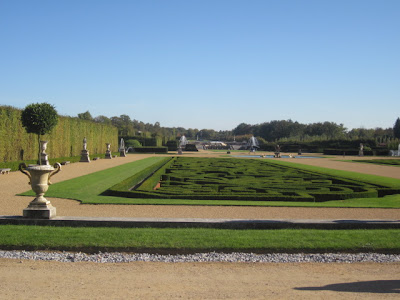+jmj+
 |
| chateau champ de bataille |
Last Saturday, I went to a castle. It was only about a half an hour from Evreux, and it has plenty neighbor castles too. Because it's France, and they like to build castles!
This particular castle was called Champ de Bataille, which in French means "battlefield". It's name comes from the 10th century. Two families were fighting over this land to build their family castles & farms. One family won the battle, and therefore the rights to this land. What was most significant about this defeat, however, was that Normandy won its independence through this battle!
The current castle was built in the 15th century by the French nobleman who was exiled by the government to this location. He built 2 main structures, connected in the middle by a courtyard, and surrounded by expansive gardens. For the next 3 centuries, the castle fell in and out of disrepair, until it was finally pillaged and abandoned during the French Revolution. For the next few centuries, it remained uninhabited until, in 1992, an interior designer named Jacques Garcia bought the property with the intention of restoring it. He spent over a decade working on the property, refinishing the interior, filling it with his own personal collection of antique furniture, artwork, tapestries, and china--all from the 17th and 18th centuries.
And that is how we come to this. Sprawling gardens, surrounded by forest and a golf course, a castle with both private accommodations for the owner as well as an entire wing dedicated to public display of period pieces, artwork, and acquired furniture. During our visit, we took a self-guided tour through the interior of the castle. It is designed according to what it would look like around the 17th/18th centuries, complete with a billiard room, formal bedrooms, sitting rooms, and the 5-room kitchen--including storage room and wine cellar.
The current castle was built in the 15th century by the French nobleman who was exiled by the government to this location. He built 2 main structures, connected in the middle by a courtyard, and surrounded by expansive gardens. For the next 3 centuries, the castle fell in and out of disrepair, until it was finally pillaged and abandoned during the French Revolution. For the next few centuries, it remained uninhabited until, in 1992, an interior designer named Jacques Garcia bought the property with the intention of restoring it. He spent over a decade working on the property, refinishing the interior, filling it with his own personal collection of antique furniture, artwork, tapestries, and china--all from the 17th and 18th centuries.
 |
| view from the edge of the gardens |
And that is how we come to this. Sprawling gardens, surrounded by forest and a golf course, a castle with both private accommodations for the owner as well as an entire wing dedicated to public display of period pieces, artwork, and acquired furniture. During our visit, we took a self-guided tour through the interior of the castle. It is designed according to what it would look like around the 17th/18th centuries, complete with a billiard room, formal bedrooms, sitting rooms, and the 5-room kitchen--including storage room and wine cellar.
 |
| the castle's own chapel |
After the interior tour, we spent well over an hour walking around the gardens outside. We were blessed with a beautiful day outside, so we took advantage of it! The gardens are very well manicured--a true garden à la française! There were even some grapevines, protected by wooden arches that reminded me of the Arboretum at U of I!




No comments:
Post a Comment